|
Fort Vancouver
Cultural Landscape Report |

|
II. EXISTING CONDITIONS
ENVIRONMENTAL CONTEXT AND SETTING
Fort Vancouver National Historic Site is located on the north bank of the Columbia River in Vancouver, Washington. Historically, the natural landscape of Columbia River's north shore was a mosaic of plains, coniferous forests, streams and lakes, with the Cascade Mountains visible in the distance. The fort stockade, the heart of the Hudson's Bay Company (HBC) operations, was located on a low-lying river plain called Fort Plain, that was approximately six miles upriver from the confluence of the Columbia and Willamette Rivers. The abundant natural resources and strategic position on the Columbia River set the stage for the site's political and economic importance beginning with the British Hudson's Bay Company, and continuing with the U.S. Army's occupation and American settlement of the Pacific Northwest. Today, the park contains approximately 208 acres and includes resources that relate to both the HBC occupation and the U.S. Army's Vancouver Barracks.
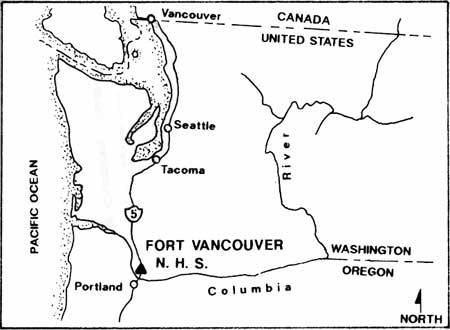
|
STUDY BOUNDARIES
Fort Vancouver National Historic Site, located in Vancouver, Washington, was established in 1948 to protect and maintain the site of the Hudson's Bay Company stockade and sufficient surrounding land to preserve the historic scene. The park was established within the boundaries of the Vancouver Military Reservation and contains land owned by both the National Park Service (NPS) and the U.S. Army. The current park boundaries include only a portion of the once vast territory that was controlled by the Hudson's Bay Company.
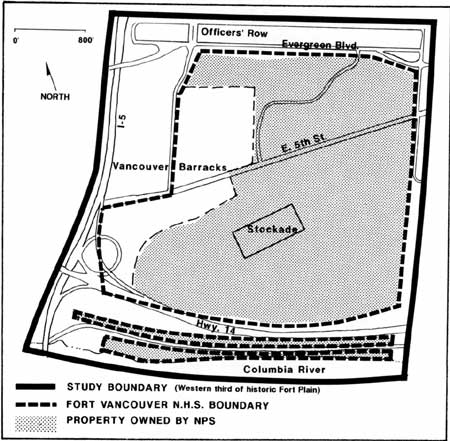
|
At its height in the 1840s, Fort Vancouver consisted of thousands of acres of forests and plains, extending for twenty-five miles along the Columbia River, and stretching north from the river for distances varying from four to fifteen miles. Principal operations took place on three large natural plains named Fort Plain, Lower Plain, and Mill Plain. Five additional plains, First Plain, Second Plain, Third Plain, Fourth Plain, and Camas Plain (referred to as the Back Plains), located north and east of the three large plains, were also periodically farmed. This area extended along the Columbia River from today's Vancouver Lake beyond Interstate 205. Although Fort Vancouver ultimately expanded to this vast area, the initial development occurred on Fort Plain, which became the administrative and geographical center of Fort Vancouver. Today, Fort Vancouver National Historic Site encompasses what was historically the core developed area of Fort Plain (approximately the western third of the historic plain).
1992 CONTEXT MAP
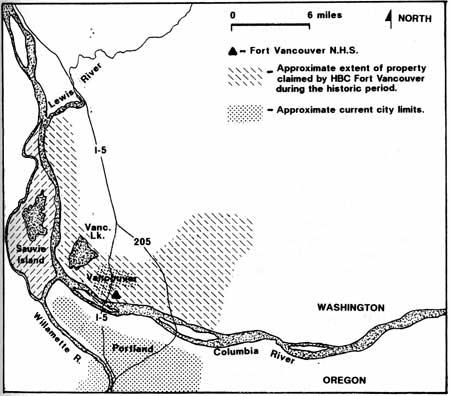
|
| Map showing the extent of historic HBC Fort Vancouver development relative to existing development. |
In order to set the appropriate historical context for all periods of development, this report includes several scales of resolution. The majority of the historical research and the analysis and evaluation focus on the historic Fort Plain, and more specifically, the western third of historic Fort Plain. This encompasses the area between Evergreen Boulevard and the Columbia River, and between Interstate 5 and East Reserve Street. The character areas and management zones narrow the focus of the report to the National Historic Site boundaries. The design recommendations are specific to property owned by the National Park Service.
SITE DESCRIPTION
Fort Vancouver National Historic Site consists of National Park Service facilities, reconstructed Hudson's Bay Company features, U.S. Army Vancouver Barracks features, Pearson Airpark, and a riverfront park. The site was listed on the National Register of Historic Places in 1966. The park boundaries includes owned by both the National Park Service (NPS) and U.S. Army.
OVERALL ORGANIZATION AND STRUCTURES
The majority of the site is owned by the NPS and generally lies north-south between Evergreen Boulevard and Highway 14, and east-west between East Reserve Street and Vancouver Barracks. The main administrative facilities and the visitor center are located on the northeast side of the park along with the main parking lot and a picnic shelter. West of the NPS administrative area is the Vancouver Barracks' parade ground and a reconstructed army bandstand.
The primary HBC interpretive resources are located south of East Fifth Street. This area consists of reconstructed buildings from Fort Vancouver at the height of its development in ca. 1846. Reconstructed buildings include the Chief Factor's House and kitchen, bake house, wash house, blacksmith's shop, Indian trade shop, bastion, and the fur store (warehouse IV). Other HBC features include an interpretive orchard and garden, located north of the stockade, and the restored historic north gate road. Wood post and rail fences, a style used during the historic period, are used to enclose most of the NPS property at the stockade and north of East Fifth Street.
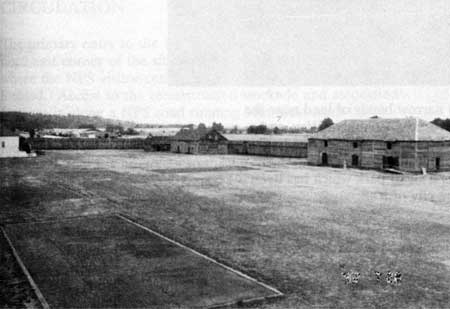
|
| View of the interior of the reconstructed HBC stockade, and reconstructed buildings. Asphalt pads mark the archeological locations of other key HBC buildings 1992. Pacific Northwest Region photo file. |
West and southwest of the stockade is an open field, NPS maintenance storage area, and the remainder of a Civilian Conservation Corps road developed at Vancouver Barracks in the mid-1930s. East and south of the stockade is Pearson Airpark, a municipal airport that is currently leased to the city of Vancouver, Washington. This extensive development consists of structures, runways, taxiways, roads, and large open spaces.

|
| View southwest from the stockade towards the Interstate bridge and interchange (historic location of the HBC river front and Kanaka Village), showing contemporary site impacts 1992. Pacific Northwest Region photo file. |
The park also includes two narrow bands of land near the river; a strip between the river and Columbia Way, and a band covering the Burlington Northern Railway embankment and Railway's right-of-way, south of Highway 14. At the west end of the riverfront strip is a small park which has been leased and developed by the city of Vancouver.
The western portion of the National Historic Site lies in the U.S. Army's Vancouver Barracks and is divided by East Fifth Street into two areas. The northern area lies between East Fifth Street and the parade ground, and between McLoughlin Road and the NPS boundary. This area lies in the eastern side of the Vancouver Barracks Historic District which was determined eligible for the National Register of Historic Places in 1986. The district includes fifteen contributing buildings, seven non-contributing structures, and numerous secondary roads.
The second Vancouver Barracks area is located between the Interstate 5/Highway 14 interchange and the NPS maintenance storage area, and between East Fifth Street and the Burlington Northern Railway embankment. This area includes several buildings from the 1930s and 1980s, roads, and parking areas.
Several areas outside the park boundaries are important because they were either historically part of HBC's Fort Vancouver, or the Vancouver Military Reservation, or both. Officer's Row, historically part of Vancouver Barracks but now owned by the city, is located north of the park, and the remainder of the Vancouver Barracks Historic District lies northwest and west of the park. Two areas southwest of the park include the City of Vancouver's Historic Apple Tree Park, and a small commercial area along the river. Pearson Airpark extends beyond the park boundaries to the east, and a city residential area lies northeast of the park.
CIRCULATION
The primary entry to the National Historic Site is near the northeast corner of the site along Evergreen Boulevard, where the NPS visitor center and visitor parking lot are located. Access to the reconstructed stockade and associated features is along a NPS road running southwest from the visitor center to East Fifth Street. A temporary parking lot is located northeast of the stockade, just off East Fifth Street. Currently, there is no access to the site from the river front.
Several major roads surround or cross the site. Interstate 5 runs along the west boundary of Vancouver Barracks, and Highway 14 and Columbia Way cross the south edge of the site, near the Columbia River. Primary east-west access roads to the park are Evergreen Boulevard and East Fifth Street. East Reserve Street and McLoughlin Road provide primary north-south access. Several secondary roads are located in the Vancouver Barracks area.
Except for an accessible path in the interpretive garden and the historic stockade north gate road, there are no formal trails or paths for pedestrians in the park. Currently, to travel between the visitor center and the stockade, pedestrians walk along the paved road, or randomly cross the large park-like open space down to East Fifth Street. Pedestrian circulation within the stockade also occurs in a random fashion.
VEGETATION
The visitor center/administrative buildings were planted in 1962 with native and non-native deciduous and coniferous trees and shrubs. Species include mugo pines, Douglas-firs, maples, oaks, and a variety of ornamental shrubs.
Vegetation in area surrounding the NPS visitor center/administrative area consists of manicured lawn, and clusters of non-native and native deciduous and coniferous trees scattered across the gently sloping land. Most of the trees south of the NPS building complex were planted in 1962. Tree species include red maples, sugar maples, sequoias, blue spruces, Douglas-firs, cherries, pin oaks, pines, and horse chestnuts. Southwest of the visitor center there is a combination of trees planted in 1962 and trees associated with non-extant Vancouver Barracks structures. Trees in this area include American hollies, Lawson cypress, western red cedars, Oregon oaks, Douglas-firs, sequoias, cherries, crabapples, plums, Pacific dogwoods, and an old variety of pear tree of unknown origin. Several of these trees are in poor condition.
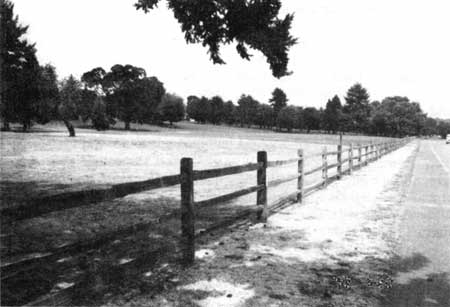
|
| View northeast from East Fifth Street towards the park-like open space south of the NPS visitor center and administrative area, 1992. Pacific Northwest Region photo file. |
The Vancouver Barracks parade ground is an open area with a manicured lawn and a few large native Oregon oak and Douglas-fir trees. Several of these trees date from the early Vancouver Barracks era and/or the Hudson's Bay Company era. Outside the park boundaries, the maple trees on both sides of Evergreen Boulevard were planted in front of Officers' Row in the 1880s, and create a strong visual edge to the north side of the parade ground.
A large number of Oregon oaks exist in Vancouver Barracks north of East Fifth Street; clumps and small groves of Oregon oaks were common in this area during the Hudson's Bay Company and Vancouver Barracks eras. The row of Douglas-fir trees in front of the barracks was likely planted in the 1930s. Other trees scattered through the area include dogwoods, maples, blue spruces, sycamores, and pines.
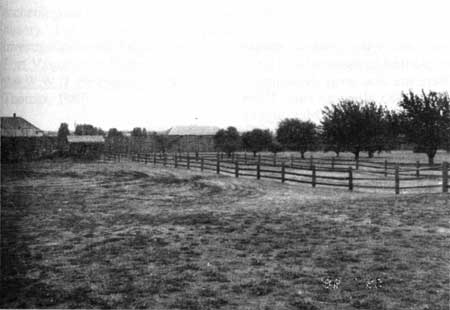
|
| View south from East Fifth Street towards the stockade, historic north gate road, interpretive garden (left), and interpretive orchard (right), 1992. Pacific Northwest Region photo file. |
In the vicinity of the stockade, vegetation consists of an interpretive orchard, planted in 1962 on the site of the HBC's garden, and an interpretive period garden, planted east of the north gate road. The 1962 Completion Report of construction projects at Fort Vancouver National Historic Site, lists thirteen species of fruit trees that were planted in the interpretive orchard: Stayman Winesap apple, red McIntosh dwarf apple, yellow Delicious dwarf apple, Elberta peach, J.H. Hale peach, Bartlett pear, Satsuma plum, peach plum, Montmorency cherry, Bing cherry, black tarterian cherry and Boston nectarine. Currently, there are seventy-one fruit trees remaining in the orchard, some are in poor condition. The remaining area, east of the historic north gate road and west of Pearson Airpark, has been seeded with red clover.
The NPS area west of the stockade consists of unmowed grasses, weeds, vetches, and a few daffodils, with large masses of blackberries and scotch broom, and a few shrubs and trees. The trees include, black locusts, a sequoia, cherries, a western red cedar, Lawson cypresses, a pine, and an aspen. Shrubs include roses, leatherleaf viburnums, quinces, and elderberries. The trees and shrubs appear to be remnants of the plantings associated with the Civilian Conservation Corps development at Vancouver Barracks in the late 1930s and 1940s.
The Vancouver Barracks area west of the stockade contains ornamental trees and shrubs planted in association with contemporary buildings. There are also large deciduous trees, including oaks, planted in 1883 along an early 1850s Vancouver Barracks depot road (later named McLoughlin Road) that led from historic Upper Mill Road (current East Fifth Street) to the riverfront.
Except for ornamental trees and shrubs planted along East Fifth Street and East Reserve Street, Pearson Airpark is mainly an open space with grasses and weeds. Near the south property line there are blackberry clumps, and a few small willow and birch trees.
The park at the river is comprised of lawns and beds with ornamental trees and shrubs. The remainder of the waterfront consists of more naturalistic riparian vegetation including masses of black cottonwoods, willows and alders.
ARCHEOLOGICAL RESOURCES
Fort Vancouver possesses historic integrity due to the concentration and significance of its archeological resources. Extensive archeological excavations and studies have been conducted since the late 1940s. Today, 1.4 million artifacts, representing the largest Hudson's Bay Company collection in the world, have been recovered. Analysis of excavated features and artifacts provides knowledge of: the physical appearance of buildings; trading, agricultural and manufacturing technology and activities; and the ethnic hierarchy and social activities of Company employees. These investigations have contributed enormously to historical and architectural knowledge of Fort Vancouver and Hudson's Bay Company operations as a whole. The Fort Vancouver-Vancouver Barracks area also contains significant archeological resources associated with the U.S. Army's history. For a more in depth summary of archeological investigations and findings see, Archeological Overview of Fort Vancouver, Vancouver Barracks, House of Providence. the W.W.II. Shipyard, Clark County, Washington, Bryn Thomas, 1987.
Investigations have been conducted throughout the site, but, to date, most have been concentrated at the fort stockade and the Kanaka Village/riverfront area. Twenty-one principal investigations have been conducted at the stockade since 1947. Excavations have revealed archeological features and artifacts from throughout the stockade's history including, the location of the stockade walls and gates, buildings, privies, the north gate road, the southwest plank road, drainage system features, fence lines, wells, flagstaffs, smudge pits, and belfries. In situ structural remains and artifacts, both excavated and unexcavated, are significant resources that have yielded and will continue to yield a wealth of scientific data. These excavations were essential in accurately locating and reconstructing the stockade and several ca. 1844/46 stockade buildings, and in interpreting the historic site.
Several principal excavations were conducted in Kanaka Village (where HBC employees lived) and the river front area between 1968 and 1982; many were carried out on army property in conjunction with the Washington State Department of Transportation's construction of the Interstate 5/Highway 14 interchange. Excavations in Kanaka Village have uncovered archeological remnants of HBC dwellings, structures, roads, the pond, fence posts, a small stockade, smudge pits, and an enormous collection of artifacts. Features and artifacts associated with Vancouver Barracks' history, dating back to 1849, include remnants of dwellings, buildings, fence posts, utility and sewage system features, water lines, refuse dumps, boardwalks (wooden sidewalks), a corral, drainage ditches, W.W.I. railroad features, and artifacts. [1] Many of these excavated areas have been disturbed or destroyed by highway and building construction in the early 1980s, but undisturbed excavations and unexcavated areas possess significant integrity.
Additional archeological investigations have also been carried out in scattered locations in the park and on adjacent army property that have exposed features and artifacts from several historic periods. A 1962 excavation conducted at the projected location of HBC agricultural barns revealed artifacts tentatively associated with the barns, and with later army features. A 1991 remote sensing study revealed several subsurface anomalies that may correspond to HBC barn features and several other hypothesized HBC building locations including the schoolhouses, root cellars, and structures in the garden and orchard. Some subsurface anomalies correlated with the hypothesized locations of a schoolhouse, well, and the summerhouse; however, only archeological excavations can confirm these findings. Several small-scale archeological excavations and monitoring projects have been conducted in response to park development, maintenance, and Section 106 compliance.
Archeological excavations and studies associated with Vancouver Barracks have been conducted in the parade ground, the Officers' Row area, the area southeast of McClelland Road, and the historic location of St. James Mission. Significant resources have been excavated in some of these areas.
Despite the large number of archeological studies in the park and in Vancouver Barracks, most of the HBC and army archeological resources have not been investigated and represent a wealth of untapped knowledge.
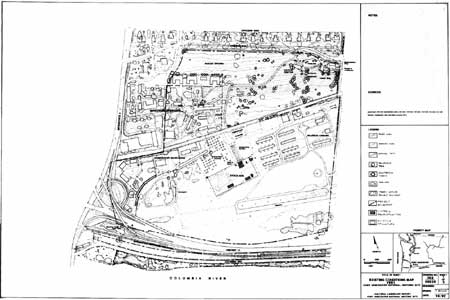
|
| Existing Conditions Map, 1991. (click on image for an enlargement in a new window) |
ENDNOTES
1. Thomas Bryn, Archaeological Overview of Fort Vancouver, Vancouver Barracks, House of Providence, the World War II Shipyard, Clark County, Washington, NPS, Cultural Resources, Pacific Northwest Regional Office, Cooperative Agreement No. CA 9000-8-0008. Prepared by Archaeological and Historical Service, Eastern Washington University, March 1992, pp. 34-80.
| <<< Previous | <<< Contents >>> | Next >>> |
fova/clr/chap2-1.htm
Last Updated: 27-Oct-2003